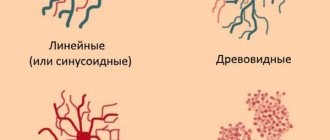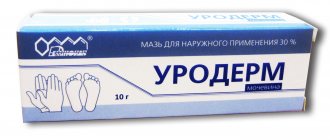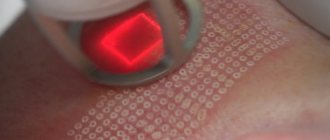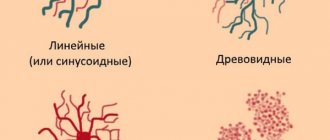A callus, or also called a dry callus, is formed as a result of prolonged friction or pressure on the skin. With chronic mechanical dermatitis, the stratum corneum of the epidermis thickens in the skin, and so-called hyperkeratosis appears. The longer and stronger the pressure is maintained, the deeper the root penetrates into the tissue. If the callus is not removed in time, an inflammatory process develops around the callus and the condition worsens.
Removal of core calluses in Moscow is carried out using modern methods using laser and radio wave surgery. By contacting our clinic at any time convenient for you, you will receive a full consultation with medical specialists. Your problem will be solved as soon as possible using modern medical methods.
Causes of calluses on the foot
The epidermis is constantly renewed due to the desquamation of the surface layer of keratinized cells and the gradual division of the lowest layer. Its cells reach the surface in approximately 28-72 days, this period is individual for everyone. Keratinization, or hyperkeratosis, is a protective reaction to external adverse effects. If it is expressed too strongly, the number of keratinized cells increases.
The processes of keratinization can intensify under the influence of various types of infection. The feet are characterized by fungal infections or infections with dermatropic types of human papillomavirus.
For the formation of a core callus, the influence of the following factors is necessary:
- uncomfortable shoes - too tight a last or too large, causing the foot to constantly slide, lack of breathable materials;
- shoes with heels - with constant use, the load on the foot is incorrectly distributed, and a callus appears in the area of the metatarsus and toes;
- shoes with flat soles - also creates an incorrect position of the foot, the load increases on the heel, which can lead to calluses in this area;
- a foreign body - a small splinter that has penetrated the surface layer of the skin and is demarcated from other tissues due to hyperkeratosis, therefore, when walking barefoot, the risk of developing a callus increases.
A dry callus can also develop into a callus if left untreated. With constant mechanical pressure, the keratinized skin does not peel off, but begins to grow inward, forming a hard core.
Laser benefits
The laser method for removing calluses has several important advantages:
- This is the safest method for removing corns. There is absolutely no risk of harming healthy tissue.
- The likelihood of getting an infection when exposed to a laser is zero. During the procedure, the laser disinfects the skin.
- The laser does not create open wounds when removing growths.
- Removal does not take much time; during one visit to the clinic, several formations on the leg can be removed at once.
- The laser easily removes growths even from the little fingers.
Using the laser method, the specialist evaporates the callus without affecting healthy skin cells.
How to recognize a callus
Pathological hyperkeratosis becomes more frequent with age. In older people, callus occurs more often. Risk factors are disturbances of vascular tone, varicose veins, diabetes mellitus, obesity and lymphostasis. With concomitant fungal infection of the feet, callus is more common.
In young people and adolescents, a callus must be differentiated from a plantar wart. External symptoms are approximately similar. A callus is characterized by the appearance of a thickened area of skin. More often it is located in the heel, metatarsal area, and a callus may appear on the toes.
The callus has clear boundaries, smooth edges, and is often round or oval in shape. It rises crater-like above the rest of the skin. The texture of the callus is dense, and in the center there is a core - a point of higher density. When pressing on a long-existing callus, pain appears that spreads into the depths of the tissue. Pain syndrome is associated with pressure on blood vessels and nerve endings located deep in the skin.
A callus is a benign formation. It does not malignize, is not accompanied by bleeding and very rarely suppurates. But it must be removed as early as possible so that discomfort when walking does not cause gait disturbances and joint problems.
What is the difference between a medical pedicure and a classic one?
Classic pedicure is a hardware method of tidying up the foot while removing the stratum corneum. For severe problems, not only aesthetics are required, but also the therapeutic nature of the procedure:
- chronic or single ingrown nails;
- hyperkeratosis;
- core calluses with a complex structure affecting the deep layers of the dermis;
- deep cracks;
- increased sweating of the feet;
- injury or deformation of the nail plate;
- deformation of fingers;
- ulcers in diabetes;
- onychomycosis.
All diseases have a complex pathogenesis and require an integrated approach to treatment. Before starting the procedures, it is recommended to make sure that the specialist is qualified: only a podiatrist – a doctor with a specialized education – can offer medical pedicure services.
Pedicure features:
- aimed at treating the disease, and not at cosmetically masking the problem;
- a variety of cutters are used, which differ in the shape and grain size of the abrasive surface;
- bloodless and safe elimination of most foot problems;
- You can correct the direction of growth of the nail plate with special staples and plates;
- removal of the roots of warts, calluses, papillomas is performed;
- hardware procedures take place without damaging the skin, which is important for older people and patients with diabetes;
- blood circulation in the legs improves.
The qualifications of a podiatrist make it possible to treat a wide range of foot diseases and diagnose pathologies that will subsequently require the intervention of highly specialized doctors.
Treatment of callus
The indication for the treatment of callus is discomfort when walking and pain. It is recommended to carry out therapeutic measures at an early stage, before the formation reaches a large size. No special diagnostics are required before treatment. An examination by a doctor is enough, who will make a diagnosis based on external signs.
But if the callus is accompanied by a fungal infection of the feet, a mycological analysis is necessary, for which samples of skin and nails are taken from foci of hyperkeratosis. In this case, with confirmed mycosis of the feet, subsequent antifungal treatment is added to the removal of the callus.
Ointments for callus
Any medications for the treatment of callus must be prescribed by a doctor. Pharmaceutical drugs are sold without a prescription, but they are used carefully so as not to harm surrounding tissues. Ointments for callus have a keratolytic effect; they soften dead cells and help remove them painlessly.
Ointments or other external products usually contain salicylic acid. it is applied 1-2 times a day under a bandage on the callus. The disadvantage of this treatment is its duration. It takes 7 days or more to completely remove the rod. In this case, painful sensations when walking persist until the wound heals.
Ointments are not recommended if there are inflammatory changes in the surrounding tissues. They are irritating and may make the condition worse. Another option for local treatment at home is a special patch for core calluses. It is glued with a healing surface to the pathological lesion and left for the whole day. Thanks to keratolytics, the callus softens and is easy to remove.
Is it possible to treat callus using traditional methods?
Using folk remedies to combat callus is not always wise. Alternative medicine suggests using heat compresses, baths with herbal decoctions, pastes from medicinal plants prepared independently, or celandine juice. The effectiveness of such methods is minimal, and the duration of treatment is difficult to determine. In some cases, it takes several weeks for the callus to be removed.
Therefore, it is better not to experiment with unknown methods, but to choose a guaranteed method of treatment.
Laser treatment of callus
You can quickly remove callus using a laser emitter. The beam acts strictly on the pathologically changed area and does not affect healthy tissue. The procedure has a number of advantages:
- painless – no pain occurs during laser exposure;
- bloodless - the core callus is located superficially, but its core goes deep. During laser treatment, the vessels are simultaneously coagulated, so bleeding does not occur;
- there is no risk of infectious complications - the laser beam has a bactericidal effect, there is no contact of the wound with surgical instruments;
- rapid recovery - wound healing occurs within 7-10 days, there is no risk of developing hyperplastic scars;
- complete removal of callus – the laser beam completely evaporates the stubble and pathologically altered skin.
Special preparation for laser removal of callus is not needed. the procedure has virtually no contraindications, but is not recommended during pregnancy, cancer patients and in the presence of inflammatory processes in the treatment area. In other cases, the issue of treatment methods is decided together with the doctor.
Removal of callus
If the tumor is large, it can be removed mechanically or surgically. Mechanical cleaning is carried out by a podiatrist using a special cutter. But the procedure can be painful due to mechanical friction and local heating of tissues. It also creates pressure on the callus tissue and its core.
Surgical removal of the callus is performed under local anesthesia. After injection of the anesthetic solution, a feeling of numbness occurs, after which the doctor painlessly removes the pathological focus. But when using a scalpel, there is a higher risk of bleeding at the site of the callus. Therefore, this method is used extremely rarely.
When surgically removing a callus, special preparation is also not needed. But after the operation, daily dressings and wound treatment are carried out.
Features of laser removal
To artificially lower the patient's pain threshold, the doctor will first give him an injection of local anesthesia. But the superficial cooling of the skin, favored by many cosmetologists, will not help much.
Next, the specialist uses a laser beam to burn out the dry formation along with the plug. Depending on the equipment model, the callus will evaporate or coagulate. After some time, the clot becomes completely autonomous, which allows it to be pulled out without damaging surrounding healthy tissue.
The cap and the rod are easily removed, preventing accompanying bleeding, as often happens with not very carefully performed surgical intervention.
One callus can be removed in approximately three to four minutes, depending on the size of the affected area and the depth of ingrowth of the rod. After pulling out the entire root system, an open wound surface remains in the tissues. To disinfect the sensitive area, a medicinal antibacterial or anti-inflammatory solution is used.
A sterile soft bandage is applied on top, which is designed to provide drainage and also protect against possible infection. Almost immediately after completion of the procedure, the patient can return to their usual pace of life. The most important warning is to temporarily avoid wearing tight shoes and high heels. To successfully complete the rehabilitation, you will have to listen to other advice and not touch the crust that has formed on top, avoid long baths, refuse to go to the sauna and bathhouse, and carefully care for the wound according to the instructions received from the expert. In total, healing will take approximately three weeks.
Restoration and prevention of callus
After removing the hyperkeratosis lesion with the core, it is necessary to keep the wound clean. At the clinic, a sterile bandage is applied to it and secured with a plaster. After the procedure, the patient can leave the clinic.
The wound on the foot is small, so no stitches are required. If you carry out daily dressings and treat them with antiseptics, you can prevent the development of complications and speed up tissue regeneration. If pain and redness, yellow purulent plaque appears, and there are no signs of healing, you should see a doctor.
To prevent hyperkeratosis, it is recommended to maintain personal hygiene and wear medium-heeled shoes carefully selected in size. If signs of a fungal infection or hyperhidrosis appear, undergo a course of treatment.
What to do with a deformed nail?
As a result of injuries, previous diseases or congenital characteristics of the body, the structure of the nail plate may change. Deformation causes pain and chronic discomfort. To treat a deformed nail, one session of medical pedicure is usually sufficient.
Symptoms:
- formation of depressions, bulges or cracks at the base on the nail plate;
- change in nail color;
- curvature of the nail;
- a sharp increase or decrease in the thickness of the nail plate.
The podologist will conduct an examination, make a diagnosis and eliminate the cause using a therapeutic or hardware method. In advanced situations, the doctor writes a referral to a surgeon.











